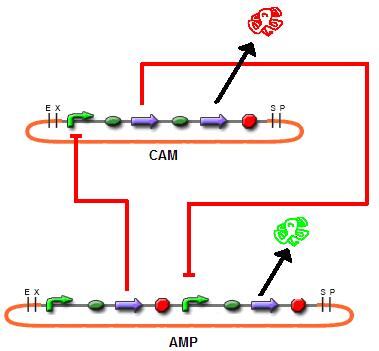Team:TUDelft/Synthetic Transcriptional Cascade: The plan
From 2009.igem.org
(Difference between revisions)
Danielsoes (Talk | contribs) (→Synthetic Transcriptional Cascade: The plan) |
Danielsoes (Talk | contribs) (→Synthetic Transcriptional Cascade: The plan) |
||
| Line 9: | Line 9: | ||
[[Image:Figure6Delay.jpg|thumb|400px|Figure 6. Synthetic Transcriptional Cascade’s Plasmid 1. Before IPTG induction the constitutive expression of cI and RFP will repress the production of GFP and the culture will glow red. The construction was made using the Biobricks [http://partsregistry.org/Part:BBa_J13002 J13002], [http://partsregistry.org/Part:BBa_C0051 C0051] and [http://partsregistry.org/Part:BBa_I13507 I13507] in a Cloranphenicol biobrick backbone [http://partsregistry.org/Part:pSB1C3 pSB1C3].]] | [[Image:Figure6Delay.jpg|thumb|400px|Figure 6. Synthetic Transcriptional Cascade’s Plasmid 1. Before IPTG induction the constitutive expression of cI and RFP will repress the production of GFP and the culture will glow red. The construction was made using the Biobricks [http://partsregistry.org/Part:BBa_J13002 J13002], [http://partsregistry.org/Part:BBa_C0051 C0051] and [http://partsregistry.org/Part:BBa_I13507 I13507] in a Cloranphenicol biobrick backbone [http://partsregistry.org/Part:pSB1C3 pSB1C3].]] | ||
| - | [[Image:Figure7Delay.jpg|thumb|400px|Figure 7. Synthetic Transcriptional Cascade’s Plasmid 2. With IPTG addition, the expression of the repressor TetR is induced which will stop the expression of cI in plasmid 1. Once the degradation of cI is enough to avoid the repression of lp, GFP will be expressed. The construction was made using the Biobricks R0010, P0440, R0051 and I13504 in an Ampicillin biobrick backbone pSB1A3.]] | + | [[Image:Figure7Delay.jpg|thumb|400px|Figure 7. Synthetic Transcriptional Cascade’s Plasmid 2. With IPTG addition, the expression of the repressor TetR is induced which will stop the expression of cI in plasmid 1. Once the degradation of cI is enough to avoid the repression of lp, GFP will be expressed. The construction was made using the Biobricks [http://partsregistry.org/Part:BBa_R0010 R0010], [http://partsregistry.org/Part:BBa_P0440 P0440], [http://partsregistry.org/Part:BBa_R0051 R0051] and [http://partsregistry.org/Part:BBa_I13504 I13504] in an Ampicillin biobrick backbone [http://partsregistry.org/Part:pSB1A3 pSB1A3].]] |
After addition of IPTG, the repressor LacI will change its configuration; this will allow the transcription of TetR in plasmid 2. This molecule will act as repressor of the promoter Ptet in plasmid 2, this stops the production of the repressor cI and red fluorescent protein (RFP). After these events, the promoter lp will be free to allow the production of GFP after a delay in time from the addition of IPTG to the final expression of GFP (Figure 8). | After addition of IPTG, the repressor LacI will change its configuration; this will allow the transcription of TetR in plasmid 2. This molecule will act as repressor of the promoter Ptet in plasmid 2, this stops the production of the repressor cI and red fluorescent protein (RFP). After these events, the promoter lp will be free to allow the production of GFP after a delay in time from the addition of IPTG to the final expression of GFP (Figure 8). | ||
Revision as of 14:56, 16 September 2009
This page is still under construction


Synthetic Transcriptional Cascade: The plan
Comparing advantages and disadvantages for both approaches (mainly the leaky problems), the negative synthetic transcriptional cascade was selected. The construction of the plasmids is as showed in figures 6 and 7.

Figure 6. Synthetic Transcriptional Cascade’s Plasmid 1. Before IPTG induction the constitutive expression of cI and RFP will repress the production of GFP and the culture will glow red. The construction was made using the Biobricks [http://partsregistry.org/Part:BBa_J13002 J13002], [http://partsregistry.org/Part:BBa_C0051 C0051] and [http://partsregistry.org/Part:BBa_I13507 I13507] in a Cloranphenicol biobrick backbone [http://partsregistry.org/Part:pSB1C3 pSB1C3].

Figure 7. Synthetic Transcriptional Cascade’s Plasmid 2. With IPTG addition, the expression of the repressor TetR is induced which will stop the expression of cI in plasmid 1. Once the degradation of cI is enough to avoid the repression of lp, GFP will be expressed. The construction was made using the Biobricks [http://partsregistry.org/Part:BBa_R0010 R0010], [http://partsregistry.org/Part:BBa_P0440 P0440], [http://partsregistry.org/Part:BBa_R0051 R0051] and [http://partsregistry.org/Part:BBa_I13504 I13504] in an Ampicillin biobrick backbone [http://partsregistry.org/Part:pSB1A3 pSB1A3].
After addition of IPTG, the repressor LacI will change its configuration; this will allow the transcription of TetR in plasmid 2. This molecule will act as repressor of the promoter Ptet in plasmid 2, this stops the production of the repressor cI and red fluorescent protein (RFP). After these events, the promoter lp will be free to allow the production of GFP after a delay in time from the addition of IPTG to the final expression of GFP (Figure 8).
 "
"








